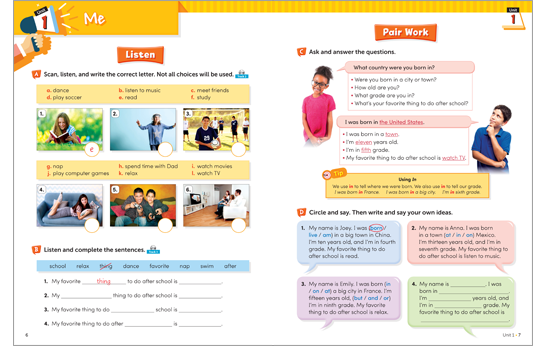반응형
Speaking for Speeches 3 Answer Keys 답지

대상: 초등중급
구성: Student Book + MP3 CD총 3권
Units: 16 (4 pages / unit)
교재 부록: MP3 CD, Video QR Codes, Transcripts, Peer Evaluation Form, Extra Ideas
구성: Student Book + MP3 CD총 3권
Units: 16 (4 pages / unit)
교재 부록: MP3 CD, Video QR Codes, Transcripts, Peer Evaluation Form, Extra Ideas
주요특징:
실제 영미권 학생들의 프레젠테이션 동영상 제공
발표자와 청중 간 관심을 고조시키고, 실제 의사소통에 도움이 되는 재미있는 토픽
학습자들의 프레젠테이션 준비에 도움이 되는 어휘 및 문장 구조 학습 및 가이드
무료 온라인 프로그램: 각 유닛과 같은 주제의 Extension 학습 제공 (영상, 단어, Read Aloud)
Each unit in the Speaking for Speeches series includes nine parts plus additional speech preparation and evaluation materials. These parts work together to guide students through the process of creating and delivering their own unique presentations. One key feature of each unit is an exclusive video of a skilled student presenter. This series is designed to give students the skills and confidence they need to successfully speak in front of an audience. A summary of each part is presented here:
Part A: uses a visually interactive listening activity designed to engage students’ interest in the unit topic. This is where students begin to get an idea of what they might write about themselves.
Part B : shows useful sentence structures. Students listen and use the word bank to complete the sentences. Here students focus on aspects of language structures that can be used in their own presentations.
Part C: In this part, students ask and answer questions designed to orally practice information for their own speeches. Students should alternate roles with multiple classmates as they practice so they can get to know all their classmates and feel more comfortable speaking in front of their peers.
Part D: gives students a chance to practice the Tip and talk more. Upon completing the second page of the unit, students will already have some key sentences ready for their own presentations.
Part E: students watch the video and listen for key phrases. If time permits, students should be encouraged to talk about the strengths and weaknesses of each presentation. The Peer Evaluation Form provided at the back of the book can be used to guide students through this process.
Part F: gives students a chance to watch the video again and follow along in their books. Here students listen for the missing words and complete the notes. This section also has an audio only option for those students who would like to listen to the content as presented by a professional voice actor.
Part G: is a brainstorming activity meant to generate ideas without placing importance on sentence structure or grammar. This is where students should focus on creativity. If students are having difficulty coming up with their own ideas, they should visit the Extra Ideas section at the back of the book.
Part H: gives students the page number corresponding to these Extra Ideas. Once students have reached this part, they are ready to write their own presentations. To the left of their writing space, students will see sentence prompts to guide their writing. Students can choose to use these prompts or create original material.
After having written their speeches, it is time for students to prepare their visual aids. The presentations in this series were created using a variety of common computer software programs. Students should be encouraged to use what is available to them. The visual aids do not have to be created using a computer. Students can create posters, cut out images from magazines, or even bring in small items.
After having written their speeches, it is time for students to prepare their visual aids. The presentations in this series were created using a variety of common computer software programs. Students should be encouraged to use what is available to them. The visual aids do not have to be created using a computer. Students can create posters, cut out images from magazines, or even bring in small items.
Part I: For this part, students first practice with their visual aids and work on memorizing their speeches. Then they give their presentations in front of the class.
Sample Pages

[ Listen ]
다양한 액티비티를 통하여, 유닛의 주제에 필요한 필수 어휘, 문장구조를 학습합니다. 이 학습을 통해 학생들은 스스로 프리젠테이션을 준비할 수 있는 기초 지식을 쌓게 됩니다.
[ Pair Work ]
학생이 프리젠테이션하기에 앞서 핵심 표현에 초점을 맞추어 간단한 문장 말하기를 연습함으로써 프리젠테이션에 자신감을 가지게 합니다.
[ Tip ]해당 유닛에서 유용하게 쓸 수 있는 문법이 간략하게 소개됩니다.

[ Presentation ]
교실에서 샘플로 촬영된 실제 비디오 프리젠테이션을 보면서, 필수 어휘와 문장구조를 듣고, 익히게 됩니다. 그리고 제공된 프리젠테이션의 notetaking 액티비티를 완성합니다.
[ Brainstorm ]
스스로 Brainstorming을 통해, 친구들 앞에서 발표할 내용을 짜임새 있게 정리해 봅니다. 이후 실제로 학급 친구들 앞에서 프리젠테이션을 하게 됩니다.

매 유닛마다 QR코드를 통해 실제 영미권 학생들의 발표 동영상을 볼 수 있습니다. 학습자들은 동영상을 통해서 발표 내용뿐만이 아니라 발표시의 태도에 대해서도 배울 수 있습니다.

1권 비디오에서는 학생들의 발표 후 선생님들의 평가가 이어집니다.
반응형